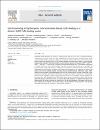Life-threatening arrhythmogenic CaM mutations disrupt CaM binding to a distinct RyR2 CaM-binding pocket

Date
2023-04-30Author
Angelos, ThanassoulasVassilakopoulou, Vyronia
Calver, Brian L.
Buntwal, Luke
Smith, Adrian
Lai, Christopher
Kontogianni, Iris
Livaniou, Evangelia
Nounesis, George
Lai, F. Anthony
Nomikos, Michail
...show more authors ...show less authors
Metadata
Show full item recordAbstract
Calmodulin (CaM) modulates the activity of several proteins that play a key role in excitation-contraction coupling (ECC). In cardiac muscle, the major binding partner of CaM is the type-2 ryanodine receptor (RyR2) and altered CaM binding contributes to defects in sarcoplasmic reticulum (SR) calcium (Ca2+) release. Many genetic studies have reported a series of CaM missense mutations in patients with a history of severe arrhythmogenic cardiac disorders. In the present study, we generated four missense CaM mutants (CaMN98I, CaMD132E, CaMD134H and CaMQ136P) and we used a CaM-RyR2 co-immunoprecipitation and a [3H]ryanodine binding assay to directly compare the relative RyR2-binding of wild type and mutant CaM proteins and to investigate the functional effects of these CaM mutations on RyR2 activity. Furthermore, isothermal titration calorimetry (ITC) experiments were performed to investigate and compare the interactions of the wild-type and mutant CaM proteins with various synthetic peptides located in the well-established RyR2 CaM-binding region (3584-3602aa), as well as another CaM-binding region (4255-4271aa) of human RyR2. Our data revealed that all four CaM mutants displayed dramatically reduced RyR2 interaction and defective modulation of [3H]ryanodine binding to RyR2, regardless of LQTS or CPVT association. Moreover, our isothermal titration calorimetry ITC data suggest that RyR2 3584-3602aa and 4255-4271aa regions interact with significant affinity with wild-type CaM, in the presence and absence of Ca2+, two regions that might contribute to a putative intra-subunit CaM-binding pocket. In contrast, screening the interaction of the four arrhythmogenic CaM mutants with two synthetic peptides that correspond to these RyR2 regions, revealed disparate binding properties and signifying differential mechanisms that contribute to reduced RyR2 association.
Collections
- Medicine Research [1739 items ]


